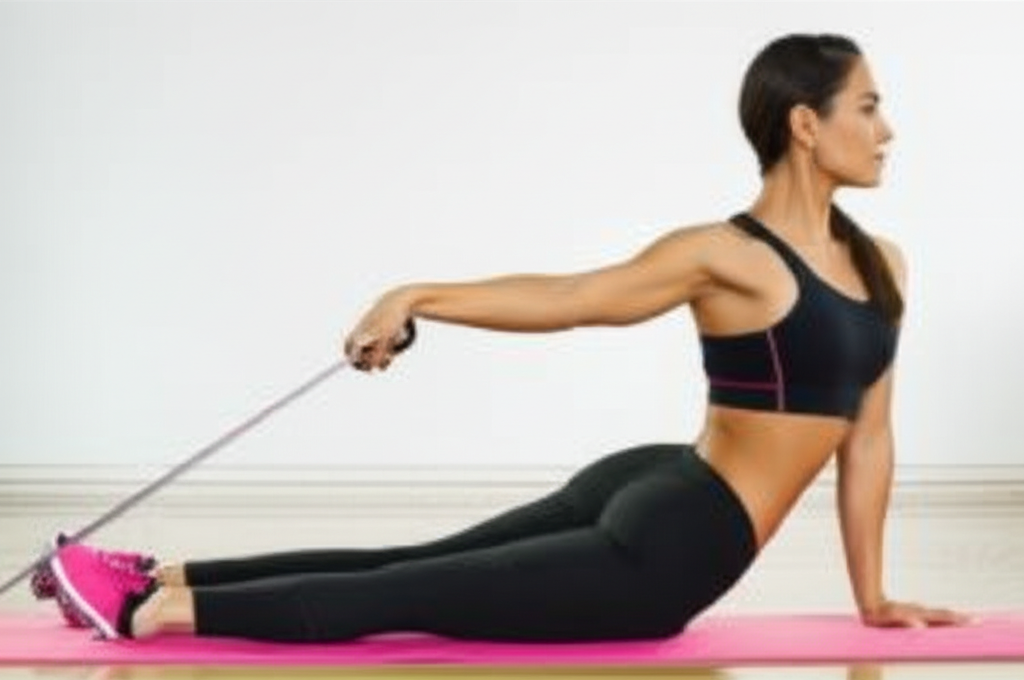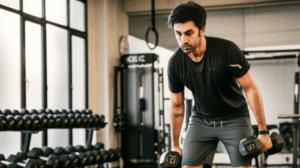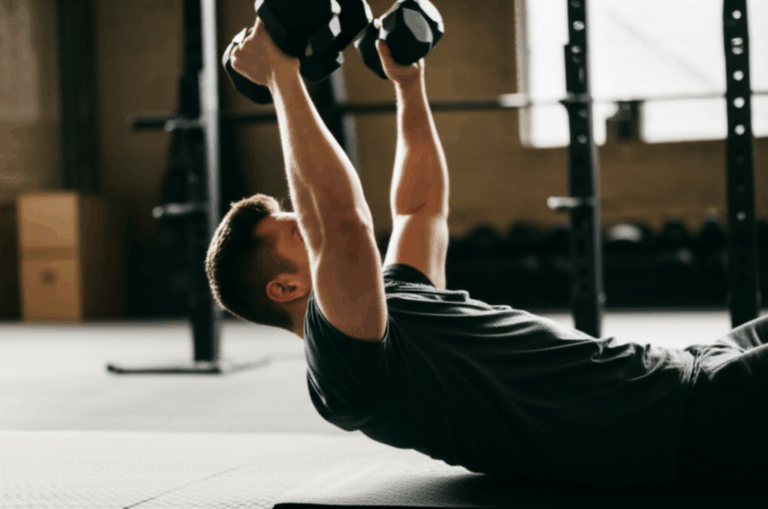Forget endless crunches and planks; building a resilient, powerful core doesn’t have to be a time-consuming chore. Your core is the unsung hero of your body, a network of muscles that stabilize, support, and power every movement, from lifting groceries to crushing a challenging workout. The good news? With just a single dumbbell and 15 minutes, you can forge an unshakeable midsection that improves your performance, protects your back, and transforms your everyday movement.
This expertly designed dumbbell core workout leverages the power of weighted resistance to challenge your muscles in new ways, promoting greater strength, stability, and definition. It’s time to unlock the true potential of your core.

Why a Strong Core is Your Body’s Best Investment
A robust core is far more than just aesthetics; it’s the foundation of optimal physical health and functional movement. These muscles — encompassing your abdomen, lower back, hips, and pelvis — work in concert to stabilize your spine and support your entire body.
Here’s why dedicating 15 minutes to your core is a game-changer:
- Improved Posture and Spinal Health: A strong core acts as a natural corset, providing essential support to your spine and promoting healthy alignment. This can significantly reduce the risk of chronic back pain and prevent excessive strain on spinal discs.
- Enhanced Balance and Stability: Your core is central to your body’s balance system. Strong core muscles provide a solid base, enabling you to maintain stability during various movements and reducing the risk of falls, particularly as you age.
- Injury Prevention: Weak core muscles can lead to imbalances, forcing other muscles to overcompensate and increasing the likelihood of injuries in your back, hips, and knees. Strengthening your core enhances overall stability, protecting your joints during daily activities and more intense exercise.
- Boosted Athletic Performance: Whether you’re an athlete or a fitness enthusiast, a strong core is crucial for generating power and transferring force efficiently between your upper and lower body. It helps maintain optimal form during workouts, leading to improved performance across the board.
- Easier Functional Movements: Everyday actions like lifting, bending, twisting, and reaching become more efficient and safer with a strong core, reducing strain and discomfort.

The Power of Dumbbells for Superior Core Strength
While bodyweight exercises are effective, incorporating dumbbells elevates your core training significantly. Dumbbells introduce external resistance, forcing your core muscles to work harder to control the load and maintain stability through each movement. This increased challenge leads to greater muscle engagement and the ability to apply progressive overload—a key principle for continuous muscle growth and strength. Using dumbbells ensures that you’re not just moving, but truly strengthening your core.

Your 15-Minute Dumbbell Core Workout Routine
This routine is designed as a circuit to keep your core engaged with minimal rest, maximizing muscle endurance and strength in a short amount of time. Aim for 3-5 rounds, moving through each exercise with purpose and proper form.
Equipment Needed: One moderate-weight dumbbell (select a weight that challenges you while allowing you to maintain good form).
Warm-up (2 Minutes)
Before diving into weighted exercises, it’s crucial to prepare your body.
- Light Cardio (30 seconds): March in place, high knees, or butt kicks to get your blood flowing.
- Cat-Cow Stretch (30 seconds): On all fours, arch your back on the inhale (cow) and round it on the exhale (cat) to mobilize your spine.
- Torso Twists (30 seconds): Stand tall with feet shoulder-width apart, gently twist your torso from side to side, keeping your hips relatively stable.
- Arm Circles (30 seconds): Small, controlled circles forward and backward to loosen the upper body.
The Dumbbell Core Circuit (10-12 Minutes)
Perform each exercise for 45 seconds, followed by 15 seconds of rest before moving to the next. Complete all exercises in the circuit, then rest for 60-90 seconds before starting the next round. Aim for 3-4 rounds.
1. Dumbbell Russian Twist
- Target Muscles: Obliques, rectus abdominis, transverse abdominis.
- How to Do It: Sit on your mat with knees bent and heels on the ground, leaning back slightly until you feel your core engage. Lift your feet off the floor, keeping your knees bent (modify by keeping heels on the ground). Hold a dumbbell with both hands in front of your chest. Rotate your torso to the right, touching the dumbbell lightly to the ground beside your hip. Then, rotate to the left, touching the dumbbell to the ground on the other side. Keep your core tight and control the movement.
- Form Tip: Avoid relying on momentum. Focus on twisting from your core, not just swinging your arms. Keep your chest open.
2. Dumbbell Pullover Crunch / Jackknife Pull-over
- Target Muscles: Rectus abdominis, transverse abdominis, obliques, lats.
- How to Do It: Lie faceup with knees bent and feet planted on the floor (for Pullover Crunch) or legs extended a few inches off the floor (for Jackknife). Hold a dumbbell vertically with both hands, arms extended overhead. Pull the dumbbell forward and up as you crunch your upper body off the floor. For the Pullover Crunch, simultaneously lift your feet off the floor, driving your knees towards your arms. For the Jackknife, lift your legs and torso simultaneously, reaching the dumbbell towards your ankles to form a “V” shape. Slowly lower back down, controlling the movement.
- Form Tip: Keep your lower back pressed into the mat throughout the movement. Focus on a controlled lower, not letting your core fully disengage.
3. Dumbbell Plank Pull-Through (Alternating Sides)
- Target Muscles: Transverse abdominis, rectus abdominis, obliques, shoulders, glutes.
- How to Do It: Start in a high plank position with your shoulders stacked directly over your wrists and a dumbbell placed just outside your left hand. Keeping your hips as still as possible and core engaged, reach your right hand under your body to grasp the dumbbell and pull it across to the right side, placing it just outside your right hand. Return your right hand to the plank position, then repeat the movement, reaching with your left hand to pull the dumbbell back to the left side.
- Form Tip: The goal is to minimize hip rotation. Imagine a glass of water on your lower back – try not to spill it!
4. Dumbbell Side Bend (Alternating Sides)
- Target Muscles: Obliques (internal and external), quadratus lumborum.
- How to Do It: Stand with feet shoulder-width apart, holding a dumbbell in one hand, palm facing inward, arm extended down by your side. Place your other hand on your hip or behind your head. Keeping your chest up and core engaged, slowly bend directly sideways towards the hand holding the dumbbell, allowing the weight to pull you down. Feel the stretch in your opposite side (oblique). Return to the starting upright position by contracting your oblique muscles. Perform for 45 seconds on one side, then switch for the next round or the next set.
- Form Tip: Avoid leaning forward or backward. Focus on a pure lateral bend to target the obliques effectively.
5. Low-to-High Dumbbell Wood Chop (Alternating Sides)
- Target Muscles: Obliques, rectus abdominis, glutes, shoulders, back.
- How to Do It: Stand with feet shoulder-width apart, knees slightly bent. Hold a dumbbell with both hands down near your right hip. In one fluid motion, rotate your torso and lift the dumbbell diagonally across your body to above your left shoulder, straightening your legs as you twist. Control the movement as you slowly reverse the motion back to the starting position. Perform for 45 seconds on one side (starting at right hip, chopping to left shoulder), then switch for the next round or set (starting at left hip, chopping to right shoulder).
- Form Tip: Power the movement from your hips and core, not just your arms. Keep your arms relatively straight but not locked.
Cool-down (1-2 Minutes)
Gently stretch your core muscles to aid recovery and flexibility.
- Cobra Stretch (30 seconds): Lie on your stomach, place hands under shoulders, and gently press up, lifting your chest while keeping hips on the floor.
- Child’s Pose (30 seconds): Kneel on the floor, sit back on your heels, and fold forward, extending arms in front of you.
- Side Bend Stretch (30 seconds per side): Stand or sit, reach one arm overhead, and gently bend to the opposite side, feeling a stretch along your oblique.

Progressive Overload and Consistency are Key
To continue building a stronger core, gradually increase the challenge over time. This can mean:
- Using a slightly heavier dumbbell.
- Increasing the number of repetitions or the duration of each exercise.
- Adding more rounds to your circuit.
- Reducing rest time between exercises or rounds.
Aim to perform this dumbbell core workout 2-3 times per week, allowing for rest days in between. Consistency is the bedrock of lasting results, leading to improved stability, reduced pain, and a core that truly supports your entire body. With this 15-minute dumbbell routine, you have a powerful tool to build the strong, resilient core you need to thrive.







